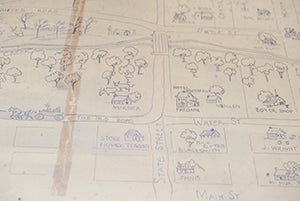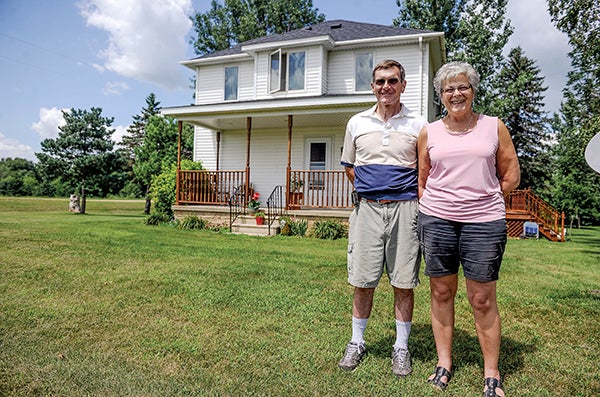History of Home: Last standing building of Frankford carries the past of a town
Published 9:30 am Sunday, August 27, 2017

- The home of Craig and Cindy Seabright appears after crossing over a rise. Around it used to be the town of Frankford. Eric Johnson/Austin Living
Cresting a small rise and just past the Frankford Cemetery, you first spy the home of Craig and Cindy Seabright.
It’s an older, two-story home surrounded by the lush greens of late summer, snugly situated on a plot of land at the corner of 795th Avenue and 251st Street.
In a way it’s unassuming and no different from so many other rural homes, but while it appears to be the perfect home for a family loving country life, it is packed with more history than the facade let’s on.
Aside from a some other homes nearby that may or may not have a similar distinction, records point to the Seabright’s home as being the last standing, originally-built home of the ghost town of Frankford.
“It’s really solid,” said Cindy as she guides visitors through the house and around the boxes packed with family mementos. The couple was in the midst of selling the historical home.
And then she adds with a laugh, “It’s not haunted either.”

A map of Frankford, drawn originally by Ruth Goodsell and then touched up by her son and granddaughter shows the Lewis Patchin farm at the corner of State and Water Streets. Eric Johnson/Austin Living
Frankford’s near miss
There is very little to distinguish the Seabright’s home as being part of Frankford, yet early, hand-drawn maps, along with Craig and family friend Bob Baarsch, who both grew up in Frankfort, remember the town as it was.
Bustling.
At its height, the community, which was built around Deer Creek, hosted three hotels, three stores, three blacksmiths and a grist mill among other several other businesses.
The Seabright home, built by Lewis Patchin, was a home along with being a hotel and post office. It was also at the center of one of the more infamous acts in Mower County history. More on that in a bit.
Frankford, in the late 1800s and early 1900s spread laterally along the creek with growth going a little ways both north and south. Going south led you a church that was across the way from the cemetery and the school.
At the time, Frankford was the county seat and looked strong enough to hold that distinction; however, legend and destiny would say otherwise.
As the story goes, in January 1857 the official papers marking Frankford as the county seat were stolen. Ruth Goodsell, a former resident of the town, wrote about the nefarious deeds as she remembered.
She wrote: “The removal of the records is based on an old letter written by Mrs. Charles Lamb, Frankford. ‘Not in the still of the night, but at noonday when the officers were taking their dinner and smoking their pipes in quietude, they came, stealing noiselessly into their vacant rooms and silently marched away with what comprised our county seat.’”
After that the history plays out like a high western, complete with posses and villains. Ultimately, the records would be carried back to Austin where despite the best efforts of those in pursuit, the records remained along with the county seat.
Just a few short years later, the town’s mystery gains a little more excitement when Goodsell writes under the heading of “The Mystery of the Old Lamb House.”
“There are rumors of dark deeds which occurred in this house in the 1870s. A gang of famous outlaws was supposed to have lived there. Hence the need for the numerous exits. The one place in the center layer of flooring near the extra window hid counterfeit plates or money until it could be picked up by other gangsters.”
“Gang members were also professional horse thieves. Horses seemed to disappear without a trace. It was said they were hidden in a large cave with camouflaged entrance. Such a cave has never been found, so Emily [Galloway] believes the cave was sealed with a rock years ago.”

Craig and Cindy Seabright stand outside their home, one of the very last reminder of the town of Frankford. Eric Johnson/photodesk@austindailyherald.com
History of a different sort
Craig Seabright and Baarsch remember a different history, even while hearing the old stories including a tale that Jesse James himself rode through Frankford, using a nearby cave to hide out in.
“I don’t doubt Jesse James staying here,” Baarsch said with a wry smile. “I’m just not sure how big a story it was.”
At some point it was Baarsch’s grandfather that took over ownership of the Patchen residence.
“I don’t know when Grandad moved here,” Baarsch said. “Dad had been born and raised here.”
Baarsch said his grandfather died when he was just five or six-years-old and afterwards the residence was rented out by his dad. Eventually the ownership of the home fell to Craig’s parents, Jerry and Deenie Seabright.
Craig remembers days of being outside, enjoying the countryside.
“There were horses and cattle and a little of everything,” he said. “We were always riding horse and things we shouldn’t be doing.”
Both Baarsch and Craig remember fishing up and down Deer Creek. At the time it wasn’t the history that spoke of the theft of papers or Jesse James, it was the history of growing up.
However, years later, Baarsch, who lives just down the road from the Seabrights, started taking a deeper interest in the area after having to put together a Power Point for a meeting of Mower County townships. As he began to dig, he began to uncover more and more of Frankford even as the old town no longer stood.
“This area outside is history,” Baarsch said. “This is the first of the prairie schooner settlements. This is an old part of the state.”
The history of home
The one thing you notice about the Seabright’s home is how sturdy it appears just from an outside glance and it’s something that Craig will agree with.
After so many years of weathering Minnesota’s weather extremes, the home still stands as strong as it did in those early days of Lewis Patchin.
“It’s held pretty square and that’s pretty amazing considering all the wind it’s seen coming across,” Craig said.
Inwardly, it’s a little harder to tell the age of the home due to some remodeling Craig and Cindy had done about 20 years previous, but a close inspection will give away the clues.
The stairs to both the basement and the second floor are steep and narrow and the rooms throughout the house are small considering how big the home appears from the outside.
In the early days, homes were built to make use of every available space.
In the basement, the most outward sign of the home’s past can be seen. Old timber used as floor bracing is still featured prominently, running parallel next to modern-day wood and pipes and while they look aged, they have not been replaced and still hold solid. At most, Craig has had to reinforce just to add a little extra bracing.
“They are in pretty good shape,” Craig said. “They didn’t put them as close together so I put some more in just to give them a little more support.”
There’s also some studs off the back porch the Seabrights suspect were the remains of what used to be a summer kitchen, an outcropping of the house that allowed to keep hotter elements of cooking away from the rest of the house.
Craig believes the slant of the studs — the way they were cut — marks the area just off their kitchen now as being the place where it stood.
Over the years the Seabrights slowly brought a more modern feel to the place. They separated off what used to be the old dining room for a larger bathroom, took out the old fireplace and remodeled the upstairs to create more private rooms for their daughters along with more bathroom space.
“The girls couldn’t be in the same room anymore,” Cindy joked.
It’s as if the home is only getting stronger. With so many years, it shows very little wear and the Seabrights can only remember water in the basement on very few occasions.
“Otherwise it’s stayed dry,” Cindy said.
And even when they were remodeling, the Seabrights were finding bits and pieces of history: wooden forks, small medicine jars and even Sunday school papers in the walls that were written in German.
Even as the Seabrights pack and prepare for the next step in their lives, it’s clear to see the pride and joy they have taken in his house, a final reminder of a small town with the history of a lifetime packed into it.
“I think it’s served us well,” Cindy said with a smile. “It’s those little things. It’s a nice cozy place.”





